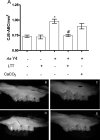Effect of Lithothamnium sp and calcium supplements in strain- and infection-induced bone resorption
- PMID: 24731063
- PMCID: PMC8638495
- DOI: 10.2319/080313-579.1
Effect of Lithothamnium sp and calcium supplements in strain- and infection-induced bone resorption
Abstract
Objective: To investigate the effect of Lithothamnium sp (LTT) supplement, a calcium-rich alga widely used for mineral reposition, on strain-induced (orthodontic tooth movement [OTM]) and infection-induced bone resorption (periodontal disease [PD]) in mice.
Materials and methods: Mice were divided into two bone resorption models: one with an orthodontic appliance and the other with PD induced by the oral inoculation of Aggregatibacter actinomycetencomitans (Aa). Both groups were fed a regular diet (vehicle), LTT-rich diet (LTT), or calcium-rich diet (CaCO3). Alveolar bone resorption (ABR), the number of osteoclasts, and the levels of tumor necrosis factor α (TNF-α), calcium, and vitamin D3 were evaluated.
Results: The number of osteoclasts was reduced in LTT and CaCO3 mice, which led to diminished OTM and infection-induced alveolar bone loss. In addition, LTT- and calcium-treated groups also presented decreased levels of TNF-α in periodontal tissues and increased levels of calcium in serum.
Conclusions: These results indicate that the LTT supplement influences ABR, probably due to its calcium content, by affecting osteoclast function and local inflammatory response, thus modulating OTM and PD.
Keywords: Bone resorption; Calcium; Orthodontic tooth movement.
Figures





Similar articles
-
Orthodontically induced root and alveolar bone resorption: inhibitory effect of systemic doxycycline administration in rats.Eur J Orthod. 2005 Jun;27(3):215-25. doi: 10.1093/ejo/cji015. Eur J Orthod. 2005. PMID: 15947219
-
Corticotomy-assisted orthodontic enhancement by bone morphogenetic protein-2 administration.J Oral Maxillofac Surg. 2012 Feb;70(2):e124-32. doi: 10.1016/j.joms.2011.10.020. J Oral Maxillofac Surg. 2012. PMID: 22260914
-
MIF induces osteoclast differentiation and contributes to progression of periodontal disease in mice.Microbes Infect. 2012 Feb;14(2):198-206. doi: 10.1016/j.micinf.2011.09.005. Epub 2011 Oct 6. Microbes Infect. 2012. PMID: 22016007
-
Immune Changes Induced by Orthodontic Forces: A Critical Review.J Dent Res. 2022 Jan;101(1):11-20. doi: 10.1177/00220345211016285. Epub 2021 Jun 9. J Dent Res. 2022. PMID: 34105404 Review.
-
The role of osteoimmunology in periodontal disease.Biomed Res Int. 2013;2013:639368. doi: 10.1155/2013/639368. Epub 2013 Sep 17. Biomed Res Int. 2013. PMID: 24151615 Free PMC article. Review.
Cited by
-
The Prevalence of Root Resorption after Orthodontic Treatment in Patients Attending a University Hospital Dental Clinic.J Pharm Bioallied Sci. 2021 Nov;13(Suppl 2):S965-S968. doi: 10.4103/jpbs.jpbs_82_21. Epub 2021 Nov 10. J Pharm Bioallied Sci. 2021. PMID: 35017908 Free PMC article.
-
A Systematic Review on the Implication of Minerals in the Onset, Severity and Treatment of Periodontal Disease.Molecules. 2016 Sep 7;21(9):1183. doi: 10.3390/molecules21091183. Molecules. 2016. PMID: 27617985 Free PMC article.
-
Do Dietary Supplements and Nutraceuticals Have Effects on Dental Implant Osseointegration? A Scoping Review.Nutrients. 2020 Jan 20;12(1):268. doi: 10.3390/nu12010268. Nutrients. 2020. PMID: 31968626 Free PMC article.
References
-
- Taddei SRA, Andrade I, Jr, Queiroz-Junior CM, Garlet GP, Garlet TP, Cunha FQ, Teixeira MM. The role of CCR2 in orthodontic tooth movement. Am J Orthod Dentofacial Orthop. 2012;141:153–160. - PubMed
-
- Garlet GP, Cardoso CR, Silva TA, et al. Cytokine pattern determines the progression of experimental periodontal disease induced by Actinobacillus actinomycetemcomitans through the modulation of MMPs, RANKL, and their physiological inhibitors. Oral Microbiol Immunol. 2006;21:12–20. - PubMed
-
- Matkovic V. Calcium metabolism and calcium requirements during skeletal modeling and consolidation of bone mass. Am J Clin Nutr. 1991;54(1 suppl):245S–260S. - PubMed
-
- Qin M, Zhang Z, Maki K, Naito M, Morimoto A, Kimura M. The effect of calcium supplement given with a mixture of calcium carbonate and calcium citrate on the mandibular alveolar bone of pubertal rats. J Bone Miner Metab. 1998;16:88–95.
-
- Lanou AJ, Berkow SE, Barnard ND. Calcium, dairy products, and bone health in children and young adults: a reevaluation of the evidence. Pediatrics. 2005;115:736–743. - PubMed
Publication types
MeSH terms
Substances
LinkOut - more resources
Full Text Sources
Other Literature Sources
Medical

